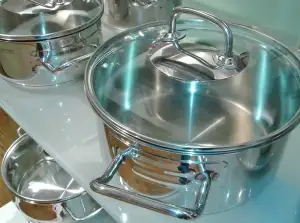Effortless Cast Iron Skillet Cleaning: A Step-by-Step Guide for a Pristine Home Kitchen

- Importance of Proper Cast Iron Skillet Maintenance
- Gather the Necessary Cleaning Supplies
- Step-by-Step Guide to Cleaning a Cast Iron Skillet
- 1. Preparing the Skillet for Cleaning
- 2. Removing Food Residue and Stains
- 3. Washing the Skillet with Hot Water
- 4. Drying the Skillet Thoroughly
- 5. Applying a Thin Layer of Oil
- Tips for Preventing Rust and Maintaining Seasoning
- Common Mistakes to Avoid When Cleaning a Cast Iron Skillet
Cleaning a cast iron skillet may seem like a daunting task, but with the right techniques and tools, it can be effortless. Cast iron skillets are known for their durability and ability to retain heat, making them a popular choice in many kitchens. However, improper cleaning can lead to rust and deterioration of the skillet's seasoning. In this guide, we will take you through the step-by-step process of cleaning your cast iron skillet, ensuring that it stays pristine and ready for your next culinary adventure.
Importance of Proper Cast Iron Skillet Maintenance
Proper cast iron skillet maintenance is essential for preserving its longevity and ensuring optimal cooking performance. Neglecting to care for your skillet can lead to rust, loss of seasoning, and even the development of harmful bacteria. By maintaining your cast iron skillet, you not only protect your investment but also enhance the flavors of your dishes. With regular cleaning and seasoning, you can enjoy a well-maintained skillet that will last for generations to come.
Gather the Necessary Cleaning Supplies
To clean your cast iron skillet effectively, you will need a few essential cleaning supplies. These include a stiff brush or sponge, coarse salt, mild dish soap (optional), hot water, and a clean towel or paper towels for drying. Additionally, you will need a heat-resistant oil or fat for seasoning the skillet after cleaning. Make sure to gather these supplies before starting the cleaning process to ensure a smooth and efficient experience.
Step-by-Step Guide to Cleaning a Cast Iron Skillet
4.1. Preparing the Skillet for Cleaning: Allow the skillet to cool completely before starting the cleaning process. Avoid using cold water on a hot skillet as it can cause the iron to warp.
4.2. Removing Food Residue and Stains: Use a stiff brush or scraper to remove any stuck-on food particles or stains. Be gentle yet thorough, ensuring all residue is removed.
4.3. Washing the Skillet with Hot Water: Rinse the skillet under hot water, using a sponge or non-abrasive brush to scrub away any remaining debris. Avoid using soap, as it can strip away the skillet's seasoning.
4.4. Drying the Skillet Thoroughly: Pat the skillet dry with a clean towel, making sure there is no moisture left on its surface. Place it on low heat for a few minutes to ensure complete drying.
4.5. Applying a Thin Layer of Oil: While the skillet is still warm, apply a thin layer of oil (such as vegetable oil or flaxseed oil) all over its surface, including the handle and exterior. Wipe off any excess oil with a paper towel.
Follow these steps after each use to maintain your cast iron skillet's cleanliness and prolong its lifespan.
1. Preparing the Skillet for Cleaning
Before you begin cleaning your cast iron skillet, it's important to prepare it properly. Start by allowing the skillet to cool down completely after use. Never attempt to clean a hot skillet as this can cause burns.
Once cooled, gently scrape off any large food particles or residue using a spatula or a stiff brush. Be careful not to scratch the surface of the skillet while doing so.
Next, rinse the skillet under warm water to remove any loose debris. Avoid using soap at this stage as it can strip away the seasoning of the skillet.
By following these initial steps, you'll be ready to tackle the next stage of cleaning and restoring your cast iron skillet to its former glory.
2. Removing Food Residue and Stains
4.2. Removing Food Residue and Stains
To remove stubborn food residue and stains from your cast iron skillet, you'll need a little extra elbow grease. Start by using a stiff brush or scrubber to gently scrub away any stuck-on bits of food. Avoid using harsh abrasives or metal scouring pads, as these can damage the skillet's seasoning.
For tougher stains, create a paste by mixing equal parts coarse salt and water. Apply the paste to the stained areas and use a cloth or sponge to scrub in circular motions. The coarse salt acts as a natural abrasive, helping to lift away the stains without scratching the surface of the skillet.
If there are still lingering stains after using the salt paste, try adding a small amount of baking soda to the mix. Baking soda is another gentle abrasive that can help break down tough stains.
Remember to be patient and persistent when removing food residue and stains from your cast iron skillet. With a little effort and the right cleaning techniques, you'll be able to restore your skillet to its original pristine condition.
3. Washing the Skillet with Hot Water
To wash the skillet, start by rinsing it with hot water. Avoid using soap as it can strip away the skillet's seasoning. Gently scrub the surface with a non-abrasive brush or sponge to remove any remaining food particles. If there are stubborn stains, sprinkle some coarse salt on the skillet and scrub again. Rinse thoroughly to ensure all residue is removed. Pat dry with a clean towel or place it over low heat on the stove to evaporate any remaining moisture.
4. Drying the Skillet Thoroughly
After washing the skillet with hot water, it is crucial to dry it thoroughly. Leaving any moisture on the surface can lead to rusting and damage the seasoning. To dry the skillet, use a clean dish towel or paper towels to absorb all the water. Make sure to wipe both the interior and exterior of the skillet until it feels completely dry to the touch. If needed, place the skillet on low heat on the stovetop for a few minutes to ensure any remaining moisture evaporates. Properly drying your cast iron skillet will help maintain its quality and prevent any potential issues in the future.
5. Applying a Thin Layer of Oil
4.5. Applying a Thin Layer of Oil
After drying the skillet thoroughly, it is crucial to apply a thin layer of oil to prevent rust and maintain its seasoning. This step helps to keep the skillet in optimal condition for future use.
To apply the oil, start by heating the skillet over low heat for a few minutes. Once heated, remove it from the heat source and add a small amount of oil to the surface. Use a paper towel or cloth to spread the oil evenly across the entire surface, including the handle and exterior.
Be sure not to use too much oil as it can lead to a sticky residue. The goal is to create a thin protective layer that will help prevent moisture from penetrating the skillet.
Once you have applied the oil, allow the skillet to cool completely before storing it. This will ensure that the oil has properly coated the surface and will help maintain its non-stick properties.
By regularly applying a thin layer of oil after each use, you can prolong the life of your cast iron skillet and enjoy its cooking benefits for years to come.
Tips for Preventing Rust and Maintaining Seasoning
To prevent rust and maintain the seasoning of your cast iron skillet, here are some useful tips. Firstly, always dry your skillet thoroughly after washing it. Any moisture left on the surface can lead to rust formation. Secondly, avoid using harsh detergents or scrub brushes that can strip away the seasoning. Instead, opt for a gentle scrub with a sponge or brush and hot water. Additionally, never soak your skillet in water for an extended period as this can also cause rusting. Lastly, after each use, apply a thin layer of oil to the skillet's surface to keep it well-seasoned and protected. Following these tips will ensure your cast iron skillet remains rust-free and maintains its non-stick properties for years to come.
Common Mistakes to Avoid When Cleaning a Cast Iron Skillet
1. Using Soap: One common mistake is using soap to clean a cast iron skillet. Soap can strip away the seasoning and leave the skillet vulnerable to rust. Stick to using hot water and a brush or sponge.
2. Soaking for Too Long: Avoid soaking your cast iron skillet for extended periods of time. Prolonged exposure to water can cause rusting. Instead, clean it immediately after use.
3. Scrubbing Too Harshly: Scrubbing with abrasive materials like steel wool can damage the seasoning on your skillet. Opt for a soft-bristle brush or sponge instead.
4. Not Drying Thoroughly: Leaving your cast iron skillet wet can lead to rust formation. After washing, dry it completely with a towel or by placing it on low heat on the stovetop.
5. Skipping Seasoning: Neglecting to apply a thin layer of oil after cleaning can result in a dull and sticky surface. Seasoning helps maintain the non-stick properties of the skillet, so don't skip this step.
By avoiding these common mistakes, you can ensure that your cast iron skillet remains in excellent condition for years to come, ready to create delicious meals in your pristine home kitchen!
In conclusion, maintaining a clean and well-maintained cast iron skillet is essential for a pristine home kitchen. By following the step-by-step guide outlined above, you can effortlessly clean your skillet and ensure its longevity. Remember to gather the necessary cleaning supplies, remove food residue and stains, wash with hot water, dry thoroughly, and apply a thin layer of oil. Additionally, take preventive measures to avoid rust and maintain the seasoning. With proper care, your cast iron skillet will continue to provide you with delicious meals for years to come.
Published: 10. 12. 2023
Category: Home



